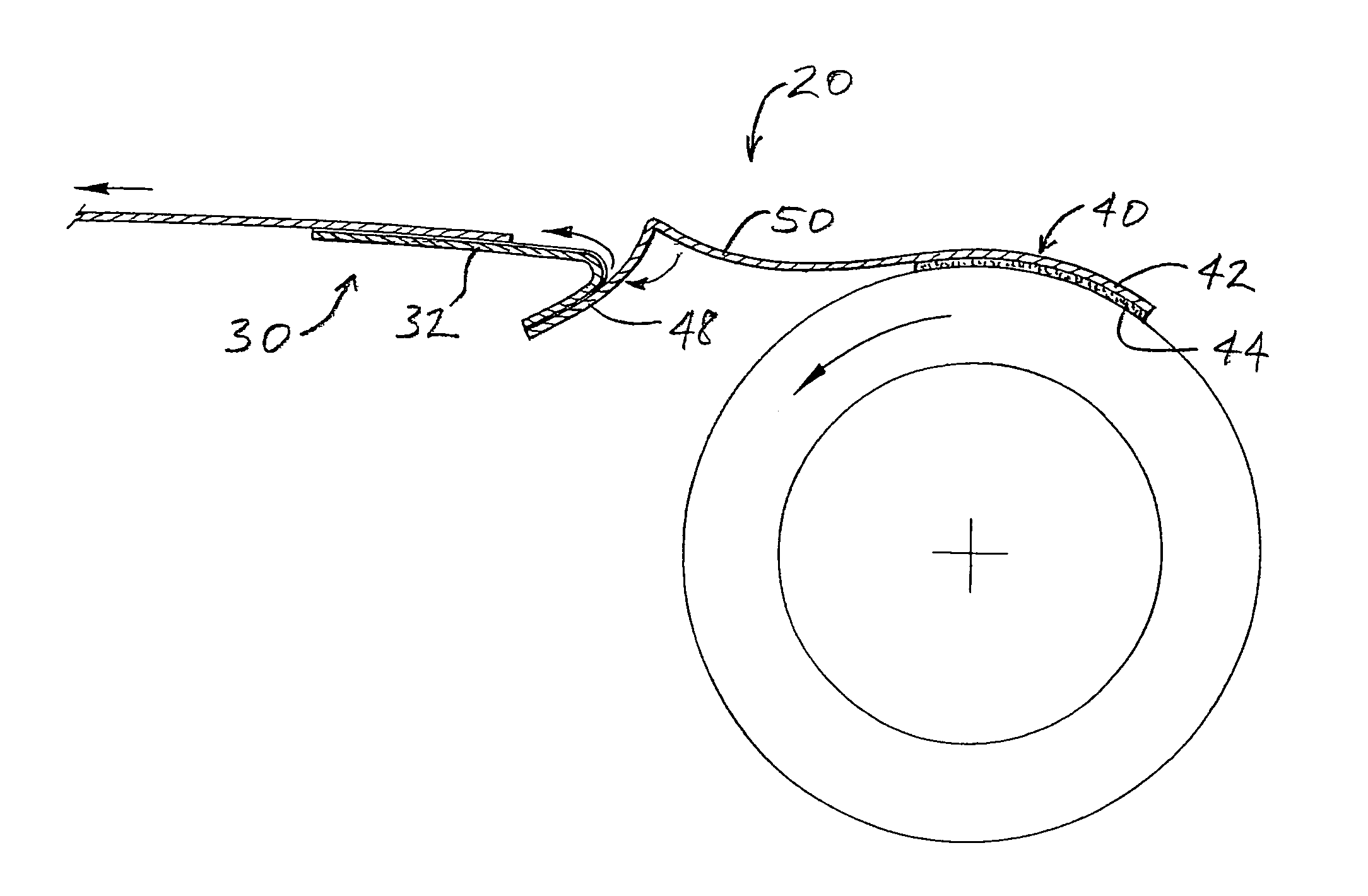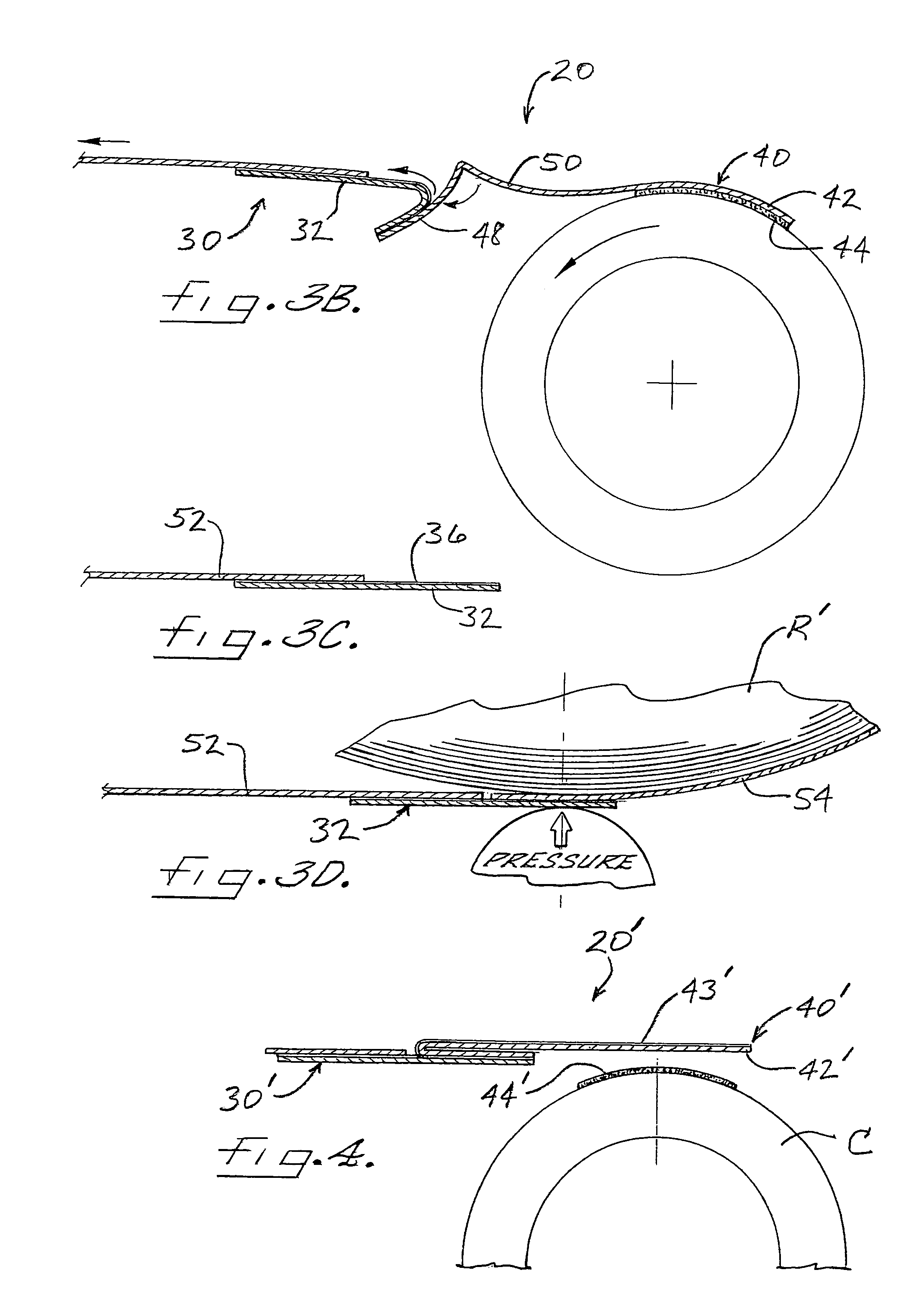Dual-functioning mechanism for startup during winding of web material and for splicing during unwinding
a technology of web material and splicing, which is applied in the direction of cellulosic plastic layered products, instruments, photosensitive materials, etc., can solve the problems of low adhesion bonding strength and portion of web components
- Summary
- Abstract
- Description
- Claims
- Application Information
AI Technical Summary
Benefits of technology
Problems solved by technology
Method used
Image
Examples
first embodiment
[0029]A dual-functioning mechanism for startup and splicing of a webs in accordance with the invention, is depicted in FIG. 1 and broadly designated by reference numeral 20. The mechanism 20 comprises a web component 30 for attachment to a tail end of a web and a core component 40 for attachment to a winding core. The web component comprises a splicing tape 32 formed by a backing 34 of suitable sheet material (e.g., paper, plastic film, cloth, etc.) and a layer of adhesive 36 covering one side of the backing. A release liner 38, which can comprise, for example, a silicone-coated paper or the like, covers the adhesive 36 on one lengthwise portion of the splicing tape and is adhered to the adhesive in releasable fashion. The remaining length of the splicing tape is adhered by the adhesive 36 to a portion of the core component 40. The adhesive 36 preferably comprises a pressure-sensitive adhesive (PSA), i.e., a material that adheres to a wide variety of materials upon application of pr...
fifth embodiment
[0046]a mechanism 220 in accordance with the invention is shown in FIG. 7. The mechanism 220 includes a web component 230 comprising a splicing tape 232 and a core component 240 comprising a substrate 242 having adhesive 244 on a core-attaching portion of the substrate. Both the splicing tape and the substrate are flat (i.e., not folded). A leading portion of the splicing tape 232 is releasably adhered to a free end portion of the substrate 242, and a tail portion of the splicing tape is adhered to the tail end 52 of a web. The mechanism thereby attaches the tail end to the core to assist in startup of winding of the web about the core to form a roll. At completion of unwinding of the roll, as the tail end of the web pulls the splicing tape 232 away from the core, the adhesive interface between the splicing tape and the core component 240 is initially placed in shear; the resulting shear stress may be sufficient to break the adhesive bond and detach the splicing tape from the core c...
sixth embodiment
[0047]FIGS. 8A and 8B depict a mechanism 320 in accordance with the invention. The mechanism 320 includes a web component 330 comprising a folded splicing tape 332 substantially as described in connection with FIG. 6. The core component 340 comprises a layer of release material 343 disposed on the cylindrical outer surface of the winding core. The leading folded portion of the splicing tape 332 is releasably adhered to the release material 343 on the core and the tail portion of the splicing tape is adhered to the tail end 52 of a web so as to attach the tail end to the core and thereby assist in startup of winding of the web about the core. At completion of unwinding, as the tail end of the web is advanced away from the core, the splicing tape 332 is pulled away from the core and unfolds and peels off from the release material 343 of the core component. Once the splicing tape completely detaches form the core component 340, the splicing tape assumes the configuration as shown in FI...
PUM
| Property | Measurement | Unit |
|---|---|---|
| adhesive bonding strength | aaaaa | aaaaa |
| length | aaaaa | aaaaa |
| tension | aaaaa | aaaaa |
Abstract
Description
Claims
Application Information
 Login to View More
Login to View More - R&D
- Intellectual Property
- Life Sciences
- Materials
- Tech Scout
- Unparalleled Data Quality
- Higher Quality Content
- 60% Fewer Hallucinations
Browse by: Latest US Patents, China's latest patents, Technical Efficacy Thesaurus, Application Domain, Technology Topic, Popular Technical Reports.
© 2025 PatSnap. All rights reserved.Legal|Privacy policy|Modern Slavery Act Transparency Statement|Sitemap|About US| Contact US: help@patsnap.com



